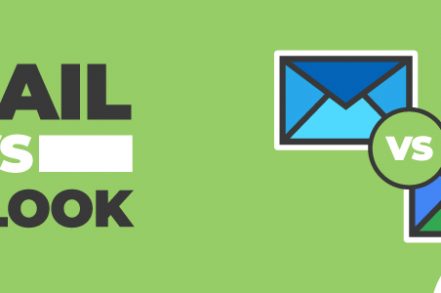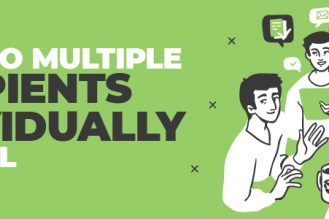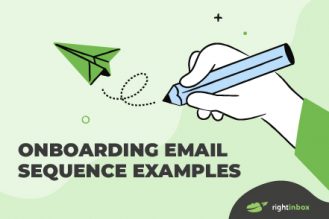With the rise in popularity of real-time communication apps like Slack, WhatsApp, and Skype, you may find it surprising that email is still the primary tool for communication at work – and with 3.9 billion users around the world, that’s unlikely to change anytime soon.
Dominating that space are Gmail and Outlook – two of the most popular email providers in the world.
Although there are a lot of similarities between the two, Microsoft Outlook is more of an email client while Gmail is essentially webmail. The major difference between an email client and webmail is that with an email client users can access their emails without the use of internet, because the emails are saved on the computer. With Gmail being a webmail there is a requirement for an internet connection to access emails.
But which one is right for you? Let’s see how Gmail vs Outlook compare in 12 key areas:
The History of Gmail and Outlook
There’s quite a lot of history behind the battle for dominance between Gmail and Outlook.
Let’s take a quick tour through the timeline.
- Outlook was originally called Hotmail and launched in 1996
- Microsoft buys Hotmail in 1997 and rebrands to MSN Hotmail
- MSN Hotmail is then rebranded to Windows Live Hotmail
- Gmail is launched in 2004 – with massive fanfare because it offered 1GB of free storage
- Eventually, Windows Live Hotmail is rebranded to Outlook to try and compete with Gmail
Despite working hard to compete, as of 2020, Outlook only has 9% of the email client market share compared to Gmail’s 28%.
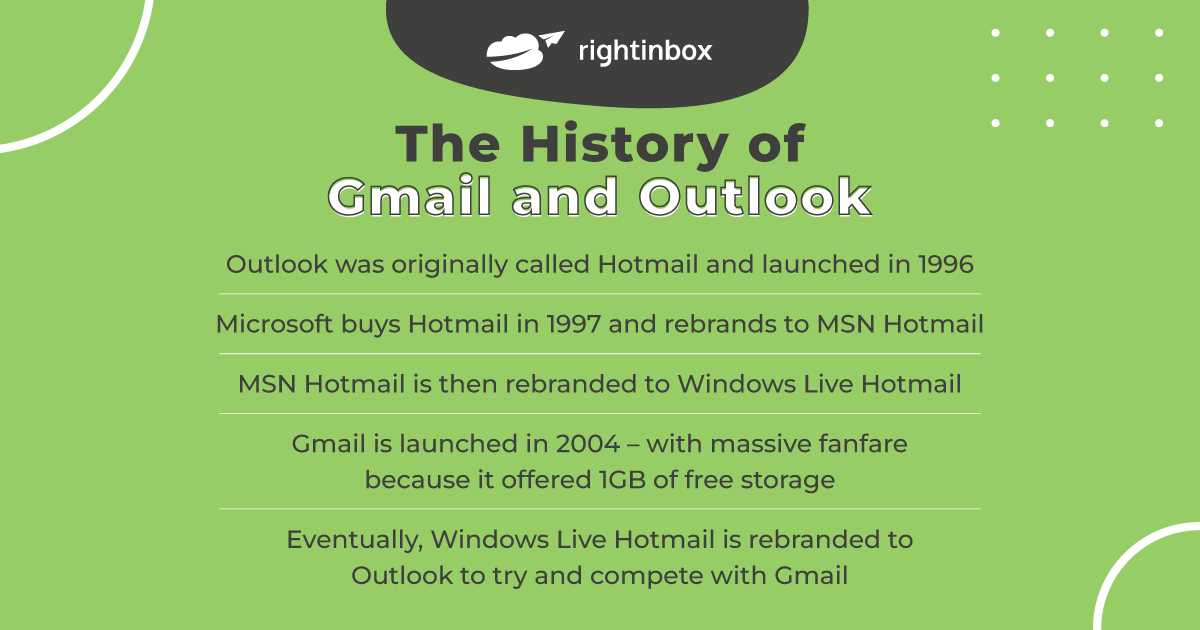
Gmail vs. Outlook: Features
Outlook’s Folder and File System
Outlook has a traditional folder and file system, much like most other email service providers. Its familiarity makes onboarding easier.
One of the downsides, though, is that Outlook’s folder and file system can feel restrictive. Emails can only be assigned to one folder, which limits how effectively you can organize your messages.
Gmail Labels
In typical Google style, Gmail’s launch changed the face of email on account of its innovative labels and categories system. It can take a little time to wrap your head around, but Gmail labels wins on features and functionality, hands down. The ability to add layers of granularity to your inbox is head and shoulders above the folder and file system.
Winner: Gmail
Gmail vs. Outlook: Design
Design can be very subjective. When it comes to choosing an email service provider, people are always going to have their own take on the look and feel that they prefer.
Today, Outlook arguably looks a little dated, while Gmail feels somewhat more cutting-edge.
The basic Gmail design:
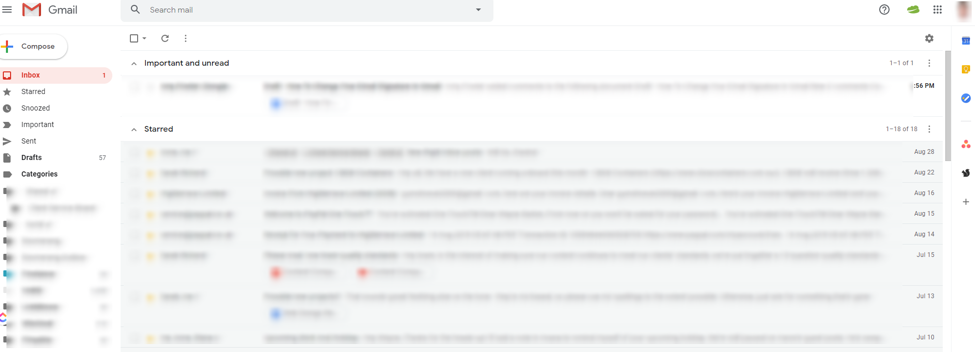
The Outlook interface:
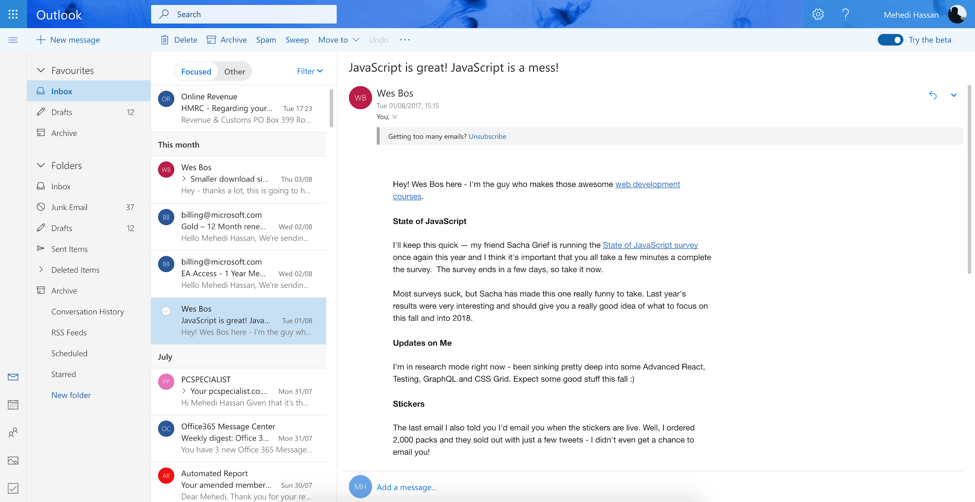
(Source)
As design and feel are so subjective, it’s difficult to declare a winner for this round.
Winner: Personal Preference
Gmail vs. Outlook: Productivity
A recent study found that office workers receive around 121 emails a day, with that number set to rise to 126 by the end of 2020. So if you’re going to keep your inbox clutter-free and your emails answered, you need to be able to customize your workflow.
Add-ons and Extensions
Let’s take a look at a few of the most popular add-ons, extensions, and add-ins for the two services:
Gmail
1. Right Inbox – Right Inbox thrives on helping people be more productive. There is a suite of tools that can help supercharge your inbox, from email reminders to customizable email templates.
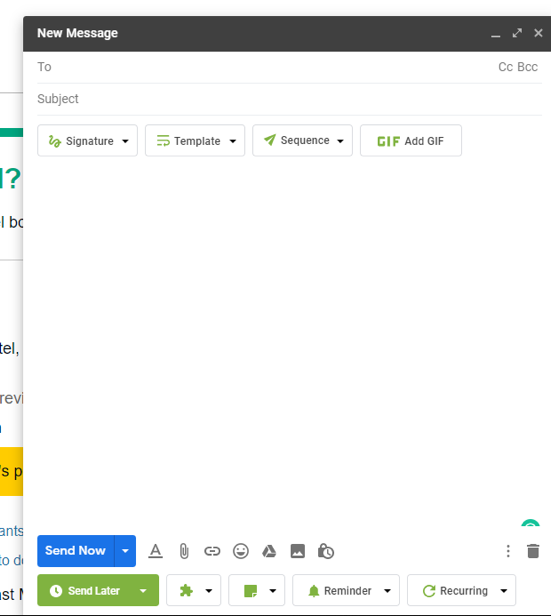
2. Crystal Knows – Have you ever wanted to discover more about someone, ahead of a key meeting? Crystal Knows can predict someone’s personality using only publicly-available data.
3. Voila Norbert – Norbert is a Chrome extension that helps you build lists and contact persons of interest to build resourceful relationships. It’s invaluable for tasks like sales and outreach.
Outlook
1. Docsend for Outlook – Docsend is a popular tool for secure file and document sharing. You can see who is reading your files and how much of those files they actually read. This is especially useful if you’re sending out proposals.
2. FindTime – Unfortunately, meetings are unavoidable. The only thing worse than a meeting that runs on too long is the chain of emails that takes place before it, in order to arrange a date and time that suits everyone. FindTime streamlines the process of pinpointing a slot in which all attendees are free.
3. Evernote – If you’re an Evernote user, then their Outlook add-in is a great way to save time on projects, and move note-taking directly into your inbox.
Who wins this round?
Simple. Gmail has so many more options for customization that it wins hands down.
Winner: Gmail
Additional Reading: 25 Best Gmail Extensions for 2024
Gmail vs. Outlook: Cost
Outlook
Personal use of Outlook in your browser is free. Beware though – there are some restrictions on these accounts. Use of the app requires Office 365, for one, which is currently about $60 a year.
Gmail
Gmail is also free to individual users (if you’re using it for work, you may need a paid account). As a standalone product, Gmail just squeaks past Outlook for the win here.
Winner: Gmail
Gmail vs. Outlook: Storage and Attachment Limits
As you know from earlier in the article, the amount of storage that comes free with the account is crucial when it comes to winning market share.
So how do Gmail and Outlook compare?
Gmail storage is capped at 15 GB for the free service, whereas Outlook now boasts 15 GB of free storage for email and then an additional 5 GB for storing files on their OneDrive cloud product.
What about attachment sizes?
Gmail allows you to send attachments up to 25 MB. Outlook, on the other hand, has a maximum attachment size of 20 MB – so not a big difference.
Winner: Outlook
Gmail Vs. Outlook: Connectivity
It’s not uncommon nowadays for users to have multiple email accounts. The thing with multiple email accounts is that you need to manage them all somehow. Many people choose to use third-party tools to help manage this. One of the most popular on the market is Thunderbird.
So how do Gmail and Outlook stack up as far as connectivity is concerned?
Gmail supports both POP and IMAP. It’s also incredibly easy to set up – in fact, you can see our guide on Gmail SMTP settings here.
Outlook also supports POP and IMAP. This means there isn’t much to call between the two. While there’s some anecdotal evidence that suggests that Gmail is a little faster, there isn’t any hard data available.
Outlook loses out a little because it’s less intuitive than Gmail when it comes to setting it up.
Winner: Gmail (only pinching it because it’s easier to set up than Outlook).
Gmail vs. Outlook: Chat
Research has shown that 46% of customers prefer live chat to email, which stands at 29%.
The good news is that both Gmail and Outlook have incorporated instant chat features. So you’re sorted if you want a quick talk with someone rather than starting an ongoing thread with long emails.
Gmail has an in-built chat functionality that you can use at any time. It was formerly Google hangouts but was rebranded to Google chat in 2020.
The latter offers the same service but is updated, has a robust team-based experience, and integrates with the G Suite for a better experience.
Outlook’s instant messaging feature is Skype which also doubles as its video and voice call feature. Skype has powerful end-to-end encryption. This means that Microsoft or anyone can’t see your message.
Plus, Skype has a more modern design Google chat can’t beat. It’s a lot easier on the eyes than the latter. It’s clear to see that the two features get the job done.
Winner: Outlook barely wins this one
Gmail vs. Outlook: Security
Security between the two email services is hard to analyze. Unless you know both systems’ architecture, it’s hard to tell exactly which one is better.
Now, it’s safe to say that both solutions don’t get breached that often. That’s why many users consider them to be safe. But for this review, we must go a little bit deeper.
And the only way to do this is by analyzing the features and products associated with their security systems.
That said, both Gmail and Outlook have spam detection features which come with two-step authentication solutions. Furthermore, the companies offer features that allow you to enable “verified” or “trusted sender” icons from trusted senders.
The only thing that tries to give Gmail a lead is its ability to see how and when your account was last used.
That said, email security usually depends on the user’s security protocols and measures. Comparing these tools in this category results in a tie.
Winner: Tie (personal preference)
Gmail Vs. Outlook: Customizability
Outlook allows you to change your app’s appearance with custom or pre-selected themes. You can slightly change how the inbox works, like how certain things can be placed.
However, Outlook really can’t compete with the sheer amount of solutions offered by Gmail.
You can customize almost everything on Gmail, from the placement and size to the overall design of your inbox and the features you use.
You can switch most features off or on. Plus, you can access semi-hidden features and settings that can improve overall productivity and experience.
Moreover, Gmail allows for the integration of numerous add-ons, which helps make it the ideal option for individuals with specific tasks.
The only major downside with Google’s product is its sheer popularity levels. There’s a high chance you won’t find the username you want.
Winner: Gmail
Gmail Vs. Outlook: Customer Support
Outlook and Gmail provide direct support from the parent companies. They also have reliable community support options. This allows you to seek help from other users by asking questions or troubleshooting problems.
Gmail’s ‘Help Center’ is an easy-to-navigate support structure. Individuals who use G Suite have access to a 24/7 customer support team to help them in real-time.
Microsoft, on the other hand, provides its users with free online chat support. Microsoft 365 users get dedicated technical support.
Gmail and Outlook’s free versions are all limited to online-based support only. To get expert services, you’ll have to upgrade. That being said, Outlook edges out Gmail in this department because of the live chat support on the free option.
Winner: Outlook
Gmail Vs. Outlook: Search
Google is the king of search. It controls 90% of the search engine market. So it can make sense to say that Gmail has similar “genes” in its in-built search function.
With a basic search, you should be able to extract whatever you’re looking for in seconds. Furthermore, Gmail users can take advantage of a wide array of advanced techniques by typing in shortcuts.
Microsoft’s Outlook has similar search functionalities. It also has advanced techniques for finding the data you’re looking for quickly.
For example, the quick view folders allow you to search through your messages. However, we can all agree that the search feature on Outlook doesn’t stack up with Gmail due to its sophistication.
Winner: Gmail
4 Reasons People Prefer Outlook to Gmail
1. Legacy Folders and Files
There’s something to be said for sticking with a system you’ve used for years. There are many people who want to maintain the same file and folder system as traditional email, which Outlook still uses. For that reason, Outlook could be easier when getting set up.
2. Microsoft Office
If you’re plugged into the Google ecosystem, then Gmail will work wonders. However, some users are still using a lot of Microsoft products such as Office 365. Because of this, Outlook could be a better choice if you’re locked into a Microsoft ecosystem.
3. Storage
Outlook wins by a slight margin in terms of storage if you’re looking to use a free email service. You can use 5GB of attachments for free, whereas Google Drive combines their email and Drive storage services, adding up to less free storage than Outlook.
There are many things you need to take into consideration when choosing an email service, from storage to attachment limits.
It’s pretty apparent though, that if you want to stay on top of your emails in 2022, you have to choose Gmail (sorry, Microsoft).
Gmail Vs Outlook Frequently Asked Questions (FAQ)
Gmail vs Outlook for business, which is better?
As more and more people move to working online, there is a big debate between which email ecosystem is better. First, you have Google’s ecosystem. This is known as Google Workspace — formerly Google Apps and then Google Suite.
A decade ago, Microsoft was still ahead of Google. But now, the internet giant has emulated virtually every service Microsoft offers and made it better. So Gmail allows you to tap into this, and is therefore the better choice for business.
Which email is best for personal use? (Gmail)
Gmail is the most used email these days. It’s free, has several features, and is incredibly easy to use. Plus, when you have a Gmail account you get access to a lot of other free applications that Google provides.
What does the future of Gmail look like?
Gmail is owned by one of the largest and growing tech companies in the world. While no one outside of Google’s boardroom could possibly know exactly what’s in store, it’s reasonable to imagine that they will continue to innovate.
What can Gmail do that I can’t with Outlook?
Gmail can do several things that Outlook cannot. For instance, the ability to create custom labels for each email allows for advanced sorting and organization. In addition, many online services require a Gmail address in order to create an account. Finally, popular extensions and add-ons like Right Inbox are only available in Gmail.
Track emails, email reminders & templates in Gmail for free
Upgrade Gmail with the features it’s missing
Add to GmailDavid Campbell
David Campbell is the editor of the Right Inbox blog. He is passionate about email productivity and getting more done in less time.
